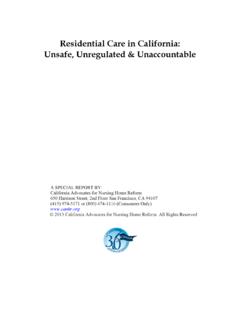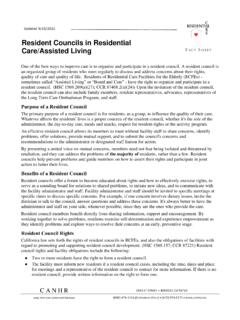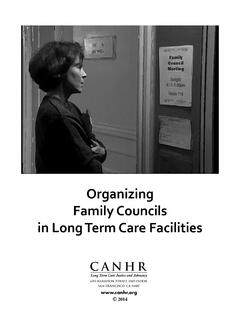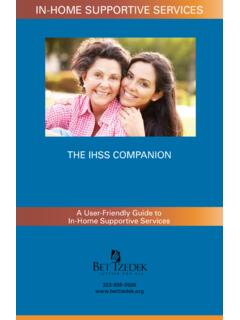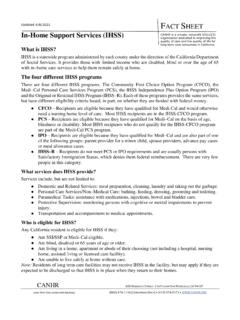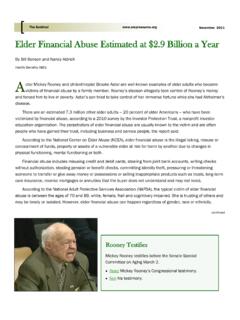Transcription of Continuing Care Retirement Communities in California
1 Continuing care Retirement Communities in California Is One Right for You? Copyright 2009. California Advocates for Nursing Home Reform (CANHR). 650 Harrison Street, 2nd Floor, San Francisco 94107. (415) 974-5171 (800) 474-1116 (Consumers only) Reprinting, and all other forms of reproduction, without permission is prohibited. Table of Contents i. What are CCRCs?..1. Background Oversight & Regulatory Enforcement ii. Personal Common Reasons to Consider CCRCs CCRC community Culture Location, Facility Characteristics & Ownership iii. Can You Afford a CCRC?..4. Entrance Fees Monthly Fees Adequacy of Income Analysis iv. What Type of CCRC Contract is Right for You?.. 6. Key Elements of Continuing care Contracts Basic Contract Types v. Assessing the Availability and Quality of Services and care ..8. Independent Units Assisted Living Nursing Home & Primary care vi. Evaluating Administrative Atmosphere of Respect Residents' Self-Determination & Independence Administration's Transparency & Experience vii.
2 Plans for Renovation/New Construction.. 11. viii. Financial Soundness of the Occupancy Rates Operating Income & Expenses Assets, Liabilities, Reserves & Legal Obligations Size of Corporation Key Introduction This Consumer's Guide provides essential information to make an informed decision regarding whether a Continuing care Retirement community (CCRC) is right for you. Over 20,000 consumers are presently living in CCRCs in California . The Guide presents essential background information and practical tips. For each section, there are key questions contained in the enclosed Points to Consider for CCRC Consumers. The topics, tips and questions are based on California Advocates for Nursing Home Reform's interaction with prospective and present residents of CCRCs and their families. The green column Tips section references forms and documents available from CCRC providers and from the State's regulatory agency (see the Key Resources section at the end of this guide).
3 Moving into a CCRC is arguably the single biggest decision consumers make during their Retirement years, and involves major lifestyle changes and significant financial commitments. Economic penalties for breaking a contract are very high, leaving many consumers with no other options once the contract has been signed. In addition to dealing with personal considerations like location, the size and age of the facility, amenities of independent living units and the overall CCRC complex, the Guide's focus is on finances yours and the providers. Is this an affordable option for you, and can you pay the substantial upfront entrance fees and ongoing charges over your lifetime? And of equal importance: is the provider financially sound, and will it be able to meet your service and care needs for the rest of your life? This Guide also deals with the different types of contracts, assessing the availability and quality of services and care , evaluating administrative practices, and plans for renovation and/or new construction.
4 Finally, key resources are identified. i. What are CCRCs? Background Continuing care Retirement Communities (CCRCs) offer housing, meals, transportation, activities, and provide a continuum of care including assisted living and nursing home care , usually in one location, and usually for the individual's lifetime. Increasingly, CCRCs have health clinics, wellness programs, and specialized dementia care services. The CCRC acts like a long term care insurance policy, guaranteeing a range of basic services at the independent living level, and higher levels of care if needed. The state of California authorizes the CCRC provider to enter into Continuing care contracts. The key feature of the Continuing care contract is the promise to provide services and care , usually, for life. There are some facilities that offer independent living and higher levels of care on one campus, but are not licensed as CCRCs. The amount of entrance Tips fees is limited ( , $10,000), but monthly fees can be very high.
5 Unlike CCRCs, there is no guarantee of future care . Contracts are often on a 1. Check DSS, Continuing care Contracts month-to-month basis. These facilities offer flexibility and care options, Branch website Sections on Laws &. but do not provide the security of CCRCs. This type of senior care Regulations and Residents ( facility is not covered in this Consumer's Guide. ) for more information on Historically, CCRCs were founded and operated by non-profit religious CCRCs and the role of the licensing and organizations ( , Presbyterians or Episcopalian and Baptist Homes) regulatory agency. or by fraternal organizations. Although non-profit organizations still dominate the CCRC scene ( , more than 80% of CCRCs in California 2. Learn about important issues for CCRC. are operated by non-profits), for- profit providers ( , Marriot, Hyatt, consumers on the CANHR website Sunrise care ) are increasingly entering this lucrative market with urban ( ). based, very upscale and expensive CCRC Communities .
6 Oversight & Regulatory Enforcement Identify and clarify your primary reasons and motivations as you evaluate whether The financial and managerial aspects of CCRCs are approved and regulated by the Department of Social Services, Continuing care the CCRC option is right for you. Contracts Branch and governed by laws found in California Health &. Safety Code Section 1770 and following. Since CCRCs offer both assisted living and nursing home care , there are additional laws and regulations governing these aspects and these units are regulated by community care Licensing, Department of Social Services, and Licensing and Certification of the Department of Public Health respectively. ii. Personal Considerations Whether a CCRC is right for you is both a financial and a personal decision. Personal considerations will be dealt with in this section, and financial issues in the next section. Personal considerations are, by their nature, subjective what is most important to you!
7 Here are some important areas to explore. Common Reasons to Consider a CCRC. One of the main attractions of CCRCs is the peace of mind that comes from meeting one's long term care needs in a single setting. It takes away the guesswork and hassle of arranging for future care needs, and produces a real sense of security in knowing that your plans for long term care are in place. There is also the added bonus of no longer maintaining a house. It might mean moving closer to one's children or siblings to increase interaction and strengthen your informal support system. And, most importantly, it relieves the concern of being a burden on friends and family. A primary value for couples is the ability to remain together, or at least be on the same campus, if one spouse requires a higher level of care . Although this is not strictly aging in place ( , living together in one's independent unit), CCRCs offer the option of aging in a community or on a campus. 2 Continuing care Retirement Communities in California Is One Right for You?
8 Tips CCRC community Culture The decision to move into a CCRC offers advantages, but also poses 1. Visit Communities several times. Stay some unique challenges. It is a permanent move and can involve leaving for a few days to experience the rou- familiar settings like the family home and neighborhood, as well as tine life and rhythm of the community , moving to another state or part of the state. It is a major lifestyle change and get a sense of its culture. to go from living in your home or apartment to a more institutional setting of a CCRC. Some individuals experience a loss of freedom 2. Make sure to view all areas of the cam- as they are confronted by the more structured and scheduled life of pus, including different care levels. an institutional setting. Others wonder about a loss of privacy and whether they will adjust to community living with scheduled meals 3. Talk with residents and staff, especial- and planned activities. ly someone from Administration, not just from Marketing.
9 Institutions like CCRCs also provide a number of services people might have been doing for themselves. Although this is often experienced as 4. Enter when healthy enough to get in- a relief, there is also a sense of a loss of independence and a feeling of volved in the life of the community and created dependency. to build relationships before requiring One of the major adjustments can be living for the first time in a peer- higher care levels, , assisted living aged community . All one's neighbors are in the same age range, and the or nursing home care . only age diversity is from staff and visitors. Some miss the laughter of children and seeing different aged people interacting in their day-to- day life. But perhaps the greatest challenge is to face one's own aging process and one's own mortality. In CCRCs, one is surrounded by both the vitality of aging as well as its decline. The nagging questions are: Am I too young for this type of community ? Will I feel comfortable in a peer-aged community ?
10 What age would I. consider entering into such a community ? What is the average age of others entering, and the average age of present residents? Another important issue is your experience of compatibility with residents you met during your visits. Is there enough common interest and background to develop relationships and to feel at home in this setting? Location, Facility Characteristics & Ownership Location, location, location! Location can be as important a consideration in choosing a CCRC as in buying a house. Instead of proximity to good schools, persons want to be close to family and friends. There might also be interest in remaining in the same area where you have lived most of your life, or in an urban setting that provides the type of cultural and civic activities you are most interested in. Climate can also be an important factor in the decision due to personal preference and/. or health considerations. The newness of the facility and the layout of the campus and its grounds can be important considerations for some consumers.

